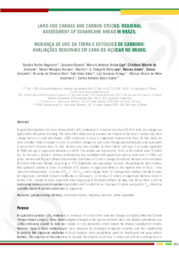Land-use change and carbon stocks: regional assessment of sugarcane areas in Brazil.
Land-use change and carbon stocks: regional assessment of sugarcane areas in Brazil.
Autoria: NOGUEIRA, S. F.; SILVA, G. B. S. da; LIGO, M. A. V.; ANDRADE, C. A. de; NOVAES, R. M. L.; MATSUURA, M. I. da S. F.; ADAMI, M.; GMÜNDER, S.; DIAS, R. de O.; KABE, Y. O.; ORTEGA, L. G.; ALCÂNTARA, M. H. M.; SODRÉ, C. A. S.
Resumo: Abstract: In agricultural product Life Cycle Assessment (LCA), emissions or removals of carbon (C) from land-use change can highly affect the global warming. The aim of this study was to evaluate the impacts of biomass C values and stock change factors on land use change (LUC) emissions in areas of sugarcane expansion in Brazil. In this study, we used stratified random sample in order to estimate changes in land cover through geotechnologies and associated C stocks from literature data. For that, the total area was stratified by three criteria: soil type, % of native vegetation in 1998 and age of sugarcane plantation in 2018. The sample size represented 12.8% of the studied area (172,000 ha). To this end, a matrix of primary combinations was combined with spatial data such as land cover in 1998, soil types, biomes and Köppen climate classification. Estimates of C stock changes in soil and biomass were calculated the Stock-Difference Method, according to IPCC Guidelines and specialized literature. Respecting the uncertainties, this approach allowed to have an estimate of C balance in sugarcane fields at the regional level in Brazil. Three main recommendations: (i) values of FMG> 1.0 (FMG, stock change factor for management regime), should be used for sugarcane, but future research ratification is necessary; (ii) biomass C values of sugarcane biomass above 5 tonnes C ha-1 should be used, especially when sugarcane is harvested without burning; and (iii) as there is still no relationship between level of pasture degradation and C content in soil, biomass C values and pasture FMG should be carefully chosen in pasture conversion to sugarcane.
Ano de publicação: 2020
Tipo de publicação: Artigo em anais e proceedings
Unidade: Embrapa Meio Ambiente
Palavras-chave: Conversion factors, Degraded pastures, Geoprocessing, Native vegetation, biomass
Observações
1 - Por padrão são exibidas publicações dos últimos 20 anos. Para encontrar publicações mais antigas, configure o filtro ano de publicação, colocando o ano a partir do qual você deseja encontrar publicações. O filtro está na coluna da esquerda na busca acima.
2 - Para ler algumas publicações da Embrapa (apenas as que estão em formato ePub), é necessário ter, no celular ou computador, um desses softwares gratuitos. Sistemas Android: Google Play Livros; IOS: iBooks; Windows e Linux: software Calibre.
Acesse outras publicações
Acesse a Base de Dados da Pesquisa Agropecuária (BDPA) para consultar o acervo completo das bibliotecas da Embrapa.

